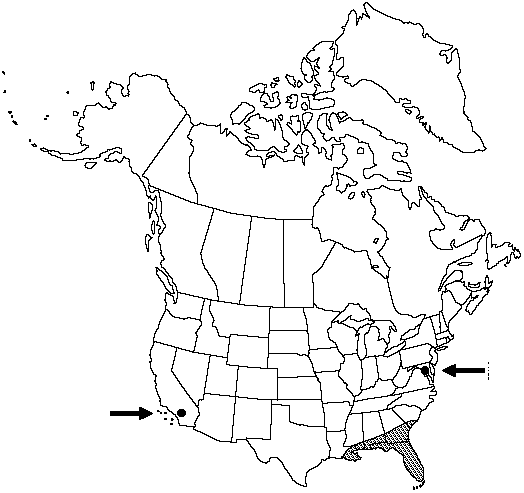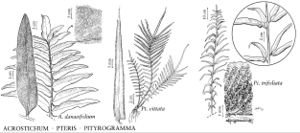Difference between revisions of "Pteris vittata"
Sp. Pl. 2: 1074. 1753, not Schkuhr. 1809.
FNA>Volume Importer |
FNA>Volume Importer |
||
| Line 20: | Line 20: | ||
}}<!-- | }}<!-- | ||
| − | --><span class="statement" id="st- | + | --><span class="statement" id="st-undefined" data-properties=""><b>Stems </b>stout, short-creeping, densely scaly; scales pale brown. <b>Leaves</b> clustered, 1–10 dm. <b>Petiole</b> green to pale brown, 1–30 cm, densely scaly; scales dense proximally, extending to and along rachis. <b>Blade</b> oblanceolate, 1-pinnate, (15–)25–50(–80) × (6–)13–25 cm; rachis not winged. <b>Pinnae</b> numerous, separated proximally, closely spaced to barely overlapping distally, not remaining green through winter, not decurrent on rachis, not articulate to rachis, linear-lanceolate to linear-attenuate, simple, 2–18 cm × 4–9 mm; base asymmetrically cordate to widened or truncate; margins serrulate, prominently so near apex; apex acuminate, attenuate, or acute; scales of rachis grading into uniseriate hairs on abaxial costae, or hairs absent on abaxial costae; proximal pinnae not divided or lobed. <b>Veins</b> free, forked. <b>Sori</b> narrow, blade tissue exposed abaxially. <b>2n</b> = 116.</span><!-- |
-->{{Treatment/Body | -->{{Treatment/Body | ||
| Line 46: | Line 46: | ||
|elevation=0–50 m | |elevation=0–50 m | ||
|distribution=Ala.;Calif.;D.C.;Fla.;Ga.;La.;Miss.;S.C.;West Indies;South America;native to Asia. | |distribution=Ala.;Calif.;D.C.;Fla.;Ga.;La.;Miss.;S.C.;West Indies;South America;native to Asia. | ||
| + | |introduced=true | ||
|reference=None | |reference=None | ||
|publication title=Sp. Pl. | |publication title=Sp. Pl. | ||
|publication year=1809 | |publication year=1809 | ||
|special status= | |special status= | ||
| − | |source xml=https://jpend@bitbucket.org/aafc-mbb/fna- | + | |source xml=https://jpend@bitbucket.org/aafc-mbb/fna-data-curation.git/src/9216fc802291cd3df363fd52122300479582ede7/coarse_grained_fna_xml/V2/V2_557.xml |
|genus=Pteris | |genus=Pteris | ||
|species=Pteris vittata | |species=Pteris vittata | ||
| − | |||
| − | |||
| − | |||
| − | |||
| − | |||
| − | |||
| − | |||
| − | |||
| − | |||
| − | |||
| − | |||
| − | |||
| − | |||
| − | |||
| − | |||
| − | |||
| − | |||
| − | |||
| − | |||
| − | |||
| − | |||
| − | |||
| − | |||
| − | |||
| − | |||
| − | |||
| − | |||
| − | |||
| − | |||
| − | |||
| − | |||
| − | |||
| − | |||
| − | |||
| − | |||
}}<!-- | }}<!-- | ||
-->[[Category:Treatment]][[Category:Pteris]] | -->[[Category:Treatment]][[Category:Pteris]] | ||
Revision as of 14:23, 27 July 2019
Stems stout, short-creeping, densely scaly; scales pale brown. Leaves clustered, 1–10 dm. Petiole green to pale brown, 1–30 cm, densely scaly; scales dense proximally, extending to and along rachis. Blade oblanceolate, 1-pinnate, (15–)25–50(–80) × (6–)13–25 cm; rachis not winged. Pinnae numerous, separated proximally, closely spaced to barely overlapping distally, not remaining green through winter, not decurrent on rachis, not articulate to rachis, linear-lanceolate to linear-attenuate, simple, 2–18 cm × 4–9 mm; base asymmetrically cordate to widened or truncate; margins serrulate, prominently so near apex; apex acuminate, attenuate, or acute; scales of rachis grading into uniseriate hairs on abaxial costae, or hairs absent on abaxial costae; proximal pinnae not divided or lobed. Veins free, forked. Sori narrow, blade tissue exposed abaxially. 2n = 116.
Habitat: Roadsides and other disturbed habitats, coastal plain
Elevation: 0–50 m
Distribution

Ala., Calif., D.C., Fla., Ga., La., Miss., S.C., West Indies, South America, native to Asia.
Discussion
Pteris vittata has escaped from cultivation. It is found on almost any calcareous substrate, such as old masonry, sidewalks, building crevices, and nearly every habitat in southern Florida with exposed limestone, notably pinelands. It is scattered throughout Florida and is sporadic, becoming less frequent to rare northward in the coastal plain.
Pteris vittata varies exceedingly in size, density of scales on the rachis, presence or absence of hairs on the abaxial costae, and overall color and aspect of the leaf. As a result, it may occasionally bear a resemblance to forms of P. × delchampsii W. H. Wagner & Nauman, the hybrid between P. bahamensis and P. vittata.
Selected References
None.
